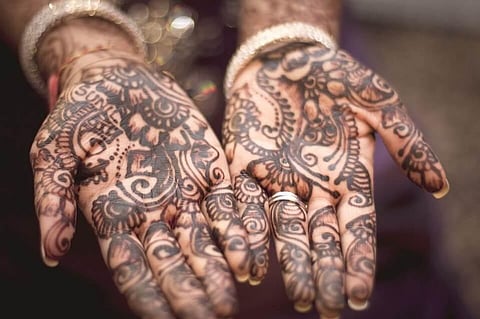
- Home
- न्यूजग्राम
- India
- World
- Politics
- Entertainment
- Culture
- Lifestyle
- Economy
- Sports
- Sp. Coverage
- Misc.
- NewsGram Exclusive
- Jobs / Internships

July 30, 2017: Mehendi is not a plain boring traditional art anymore. With changing needs of people, numerous mehendi designs and colors are adding vividness to the art and making it interesting around the globe.
Mehendi reaches new heights in terms of demand every festival and it is turning into a lucrative business. The applying of henna by women has become a tradition across the country. Mehendi artists get busy in decorating women's hands on the eve of the festival or a marriage. Hundreds of women turn up in big groups, waiting for their requisite hand-candy.
Mehendi is avidly applied to the hands is during weddings and karvachauth. Though its demand may fluctuate through the year, applying Mehendi is a more of a tradition which is deeply ingrained in Indian culture. Many to be bride puts it on carrying a belief that the darker the shade of her mehndi, the more happily married she will be.
[bctt tweet="Mehendi reaches new heights in terms of demand. " username="NewsGramdotcom"]
Mehendi is not merely for people who believe in customs and traditions. Henna can be seen adopting funky patterns around the globe- Madonna has an Om symbol on the hand, Rihanna flaunts a Maori henna-inspired tattoo or a blue-haired Gwen Stefani has a paisley printed on her bare shoulder.
The usual mehndi customer indulge in- routine winding trellises, multi-tiered florals, and paisleys trailing down the hand, stretching on to the wrists, decorating the back of the hand and then, the feet. The new age woman can also opt for a band to be etched on her upper arm, lower arm or around her ankle.
What is interesting is the slight changes done in Mehendi designs like a change in color and distinctive patterns, for instance. Here are some of the trends that we've noticed:
Largely popularized by pop-star Rihanna, Maori designs are a funky alternative to the usual henna patterns. Maori designs are inspired by the Maori tribes of New Zealand, has distinctive patterns- sharp zig-zags, pointy stars, fish hooks, mantises and artistically shaped fish, among others.
The designs usually have symbolic interpretations: 'water'-inspired designs to speak of the balance between the spiritual and material world, fish hooks symbolize good fortune and heart shaped leaves are said to have healing energy.
With time there have been various innovations in Mehendi design like customization. There are brides who stay away from the conventional motifs and instead opt for their love stories to be etched out on their hands- skylines of places where they first met the groom, special mementos, and important events.
There are some enthusiastic people who are entering avant-garde territory opting for- calligraphy, a peace sign, city skylines, prayer bead patterns done on the wrist like a bracelet or even prints that resemble lacy gloves. There's a lot scope for experimentation in terms of Mehendi designs which can be incorporated by future brides looking for ideas and inspiration.
– prepared by Kritika Dua of NewsGram. Twitter @DKritika08
NewsGram is a Chicago-based non-profit media organization. We depend upon support from our readers to maintain our objective reporting. Show your support by Donating to NewsGram. Donations to NewsGram are tax-exempt
Click here– www.newsgram.com/donate
